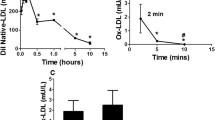Abstract
Lycopene is a lipophilic antioxidant that is largely transported in human blood by Low Density Lipoproteins (LDL). One of the early events in the aetiology of atherosclerosis is thought to be the oxidation of LDL. Myeloperoxidase an enzyme secreted by neutrophils and macrophages is thought to oxidise human LDL particles. In this study, isolated human LDL was challenged with myeloperoxidase or copper, and the LDL was screened for lipoperoxidation and oxidation of apolipoprotein B100, depletion of lycopene and oxidation of cholesterol. Myeloperoxidase induced oxidation of LDL through direct interaction with apolipoprotein B100. No lipoperoxidation was observed following myeloperoxidase treatment; however, 7-ketocholesterol was detected indicating the products of myeloperoxidase interact with the surface of the LDL particles. Lycopene does react with the products of myeloperoxidase in solvent, but played no role in protecting against enzyme derived oxidation of human LDL.






Similar content being viewed by others
References
Lapenna D, Cuccurullo F (1996) Hypochlorous acid and its pharmacological antagonism: an update picture. Gen Pharmacol 27:1145–1147
Vissers MC, Winterbourn CC (1995) Oxidation of intracellular glutathione after exposure of human red blood cells to hypochlorous acid. Biochem J 307:57–62
Levitan I, Volkov S, Subbaiah PV (2010) Oxidised LDL: diversity, patterns of recognition, and pathophysiology. Antioxid Redox Signal 13:40–75
Stocker R, Keaney JF Jr (2004) Role of oxidative modification in atherosclerosis. Physiol Rev 84:1381–1478
Hazen SL, Heinecke JW (1997) 3-Chlorotyrosine, a specific marker of myeloperoxidase-catalysed oxidation, is a markedly elevated in low density lipoproteins isolated from human atherosclerostic intima. J Clin Investig 99:2075–2081
Whiteman M, Siau JL, Halliwell B (2003) Lack of nitration by hypochlorous acid in the physiological concentrations of nitrite. Implications for the role of nitryl chloride in tyrosine nitration in vivo. J Biol Chem 278:8380–8384
Wang Z, Nicholls SJ, Rodriguez ER, Kummo O, Horkko S, Barnard J, Reynolds WF, Topol EJ, DiDonato JA, Hazen SL (2007) Protein carbamylation links inflammation, smoking, uremia and atherogenesis. Nat Med 13:1176–1184
Riccioni G, Mancini B, Di Ilio E, Bucciarelli T, D’Orazio N (2008) Protective effect of lycopene in cardiovascular disease. Eur Rev Med Pharmacol Sci 12:183–190
Rao AV, Rao LG (2007) Carotenoids and human health. Pharmacol Res 55:207–216
Lindshield BL, Canene-Adams K, Erdman JW Jr (2007) Lycopenoids: are lycopene metabolites bioactive? Arch Biochem Biophys 458:136–140
Sommerberg O, Langhans CD, Arnhold J, Leichsenring M, Salerno C, Crifo C, Hoffman GF, Debatin KM, Siems WG (2003) β-Carotene cleavage products after oxidation mediated by hypochlorous acid-a model for neutrophil derived degradation. Free Radic Biol Med 35:1480–1490
Pennathur S, Maitra D, Byun J, Sliskovic I, Abdulhamid I, Saed GM, Diamond MP, Abu-Soud HM (2010) Potent antioxidative activity of lycopene: a potential role in scavenging hypochlorous acid. Free Radic Biol Med 49:205–213
Graham JM, Higgins JA, Gillott T, Taylor T, Wilkinson J, Ford T, Billington DA (1996) Novel method for the rapid separation of plasma lipoproteins using self-generating gradients of iodixanol. Atherosclerosis 124:125–135
Takaichi S (2000) Characterization of carotenes in a combination of a C18 HPLC column with isocratic elution and absorption spectra with a photodiode-array detector. Photosynth Res 65:93–99
Malhotra, HC, Britton G, Goodwin TW (1970) Occurrence of 1,2-dihydro-carotenoids in Rhodopseudomonas viridis Chem Comun 127–128
Khachik F, Goli MB, Beecher GR, Holden J, Lusby WR, Tenorio MD, Barrera MR (1992) Effect of food preparation on qualitative and quantitative distribution of major carotenoid constituents of tomatoes and several green vegetables. J Agric Food Chem 40:390–398
Esterbauer H, Gebicki J, Puhl H, Jurgens J (1992) The role of lipid peroxidation and antioxidants in oxidative modification of LDL. Free Radic Biol Med 13:341–390
Lowe GM, Bilton RF, Davies IG, Ford TC, Billington D, Young AJ (1999) Carotenoid composition and antioxidant potential in sub-fractions of human low-density lipoprotein. Ann Clin Biochem 36:323–332
Gruszecki WI, Strzalka K (2005) Carotenoids as modulators of lipid membrane physical properties. Biochim Biophys Acta 1740:108–115
Hevonoja T, Markku O, Pentikainen MT, Hyvonen PT, Mika A-K (2000) Structure of low density lipoprotein (LDL) particles: basis for understanding molecular changes in modified LDL. Biochim Biophys Acta 1488:189–210
Lagor WR, Millar JS (2010) Overview of the LDL receptor: relevance to cholesterol metabolism and future approaches to the treatment of coronary heart disease. J Recept Ligand Channel Res 3:1–14
Van Dalen CJ, Winterbourne CC, Senthilmohan R, Kettle AJ (2000) Nitrite as a substrate and inhibitor of myeloperoxidase. Implications for nitration and hypochlorous acid production at sites of inflammation. J Biol Chem 275:11638–11644
Milde J, Elstner EF, Grassmann J (2007) Synergistic effects of phenolics and carotenoids on human low-density lipoprotein oxidation. Mol Nutr Food Res 51:956–961
Romanchik JE, Morel DW, Harrison EH (1995) Distributions of carotenoids and alpha-tocopherol among lipoproteins do not change when human plasma is incubated in vitro. J Nutr 125:2610–2617
Patel RP, Darley-Usmar VM (1999) Molecular mechanisms of the copper dependent oxidation of low-density lipoprotein. Free Radic Res 30:1–9
Pattison DI, Hawkins CL, Davies MJ (2003) Hypochorous acid mediated oxidation of lipid components present in low density lipoproteins: absolute rate constants, product analysis and computational modelling. Chem Res Toxicol 16:439–449
Napolitano M, De Pascale C, Wheeler-Jones C, Botham KM, Bravo E (2007) Effects of lycopene on the induction of foam cell formation by modified LDL. Am J Physiol Endocrinol Metab 293:1820–1827
Acknowledgments
The authors would like to thank the European Commission Sixth Framework Programme for funding the project LYCOCARD (Contract No. 016213). Finally we would like to thank all the volunteers at LJMU for their kind donation of blood.
Conflict of interest
None
Author information
Authors and Affiliations
Corresponding author
Rights and permissions
About this article
Cite this article
Chew, P.Y., Riley, L., Graham, D.L. et al. Does lycopene offer human LDL any protection against myeloperoxidase activity?. Mol Cell Biochem 361, 181–187 (2012). https://doi.org/10.1007/s11010-011-1102-0
Received:
Accepted:
Published:
Issue Date:
DOI: https://doi.org/10.1007/s11010-011-1102-0




